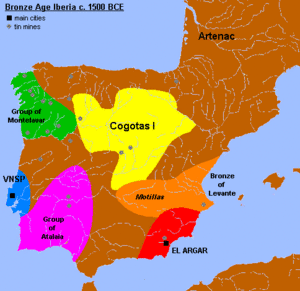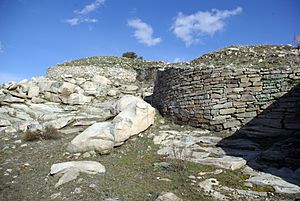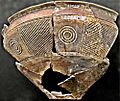Las Cogotas facts for kids
 |
|
| Geographical range | Spain |
|---|---|
| Period | Bronze Age, Iron Age |
| Dates | 1700 BC |
| Preceded by | Bell Beaker culture, El Argar |
| Followed by | Vettones, Roman Republic |
Las Cogotas is an important archaeological site in Spain. It is located in the town of Cardenosa, within the province of Avila. An archaeologist named Juan Cabré first studied this site in the 1920s.
The name "Las Cogotas" is used for two different ancient cultures found here. These are called Cogotas I and Cogotas II. Cogotas I existed during the Late Bronze Age. Cogotas II appeared later, during the Iron Age. The upper parts of the Las Cogotas site show a classic settlement of the Vettones. These people lived in areas that are now parts of Avila, Salamanca, Toledo, Zamora, Cáceres, and Tras-os-Montes in Portugal.
Contents
The Early Cogotas Culture
This early period in the Meseta region of Spain is not fully understood. However, discoveries at other sites help us learn about it. This stage is sometimes called the Protocogotas culture. It was a starting point for the later Cogotas I culture.
This culture existed around 1700 to 1550 BC. It was influenced by earlier groups like the Bell Beaker culture. Even though no direct finds from this period were made at Las Cogotas itself, it set the stage for what came next.
The Cogotas I Culture
One special thing about the Cogotas I culture is its pottery. They made black pottery with designs carved into it. These designs were then filled with a white paste. This style is known as Cerámica de Boquique. The pots were usually small and had flat bottoms. They were likely used for cooking.
Here is a timeline for the Cogotas I culture:
- Around 1700 BC: The culture began to form (Protocogotas stage).
- Around 1550 BC: Pottery with carved and white-filled designs became common.
- Around 1350 BC: People started trading goods over longer distances.
- Around 1100 BC: The culture expanded to new areas.
- Around 1000 BC: The Cogotas I culture disappeared.
The Cogotas II Culture
Around 1000 BC, new groups of people arrived in the Iberian Peninsula. These included the Celts and other Indo-European tribes. They settled in central and western Spain. They created new cultures, often on top of older ones. One of these new groups was the Vettones. They were likely of Celtic origin.
A famous feature of the Cogotas II culture is their verraco statues. These are large stone statues, often shaped like bulls or pigs. They were placed in areas where animals grazed. We are still not sure exactly why they made these statues.
Other items found from this culture include daggers and flat axes made of copper. They also used sickles for farming and stone tools for grinding grain. People also used spindle whorls for spinning thread.
Like other settlements of its time, the Cogotas II site was organized into different areas. It had places for keeping cattle and a special burial ground called a necropolis. Raising cattle was very important to the Vettones. This might explain why they made so many animal statues.
Gallery
-
Cogotas II. A granite verraco near Mingorria
See also
 In Spanish: Las Cogotas para niños
In Spanish: Las Cogotas para niños
Literature
- Historia de Castilla y León. 1. La prehistoria del Valle del Duero, Valladolid, 1985. G. Delibes.
- La Cultura de las Cogotas I, Actas del Homenaje a Luis Siret, Sevilla, 1986. Mª. D. Fernández Posse.














